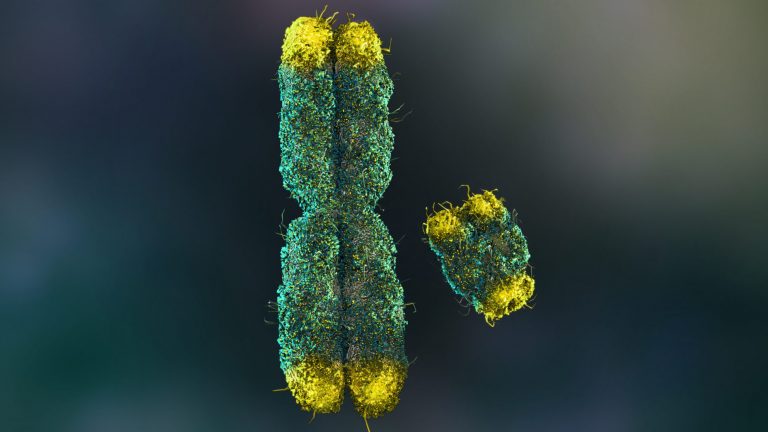Chromosomes X and Y and Sex Determination

3D Rendering of X and Y Chromosomes (with telomeres)
Table of Contents
Reviewed by: Mary Anne Clark, Ph.D.
In humans, the normal chromosome complement is 46, consisting of 22 pairs of autosomes, chromosomes that are the same in both males and females, and one pair of mostly unmatched sex chromosomes, which determine the sex of an organism and various sex-linked characteristics.
In mammals, the sex chromosomes are called X and Y. Females have paired X chromosomes, one from each parent, while males have an X and a Y chromosome. Males get their single X chromosome only from their mothers and their Y chromosome only from their fathers. In other species, for example, birds and rattlesnakes, the male has two copies of a Z chromosome, while the female has a Z and a W.
Sex Determination
A humans’ sex is predetermined in the sperm gamete.
In mammals, females are said to be homogametic because all their gametes contain an X chromosome. Males are called heterogametic because they produce both X bearing gametes and Y-bearing gametes. The sex chromosome in the sperm cell then determines the sex of the zygote. X-bearing sperm produces females and Y-bearing sperm produces males. Interestingly the Y sperm swim just a little faster, so a few more males are initially produced. However, this male advantage is countered later in development by deleterious genes exposed to the X chromosome, so that the birth rate of males and females is about equal.
Chromosomes X and Y
Chromosomes X and Y do not make up a fully homologous pair. The X chromosome in humans is much longer than the Y chromosome and also contains many more genes. However, there is a short region on both the X and Y chromosomes, called the pseudoautosomal region (PAR), that allows the X and Y chromosomes to pair during meiosis for equal distribution of the two chromosomes. Only a few genes are in this region, including the gene for amelogenin, which produces tooth enamel.
Genes on the X chromosome are said to be X-linked or sex-linked. Because only females normally get two X chromosomes, dominance of X-linked genes is only expressed in females. Since males only get one X chromosome, all of their X linked alleles are expressed in the phenotype, regardless of dominance.

In the figure above, the arrows represent sex-linked genes in the X chromosome. In this homologous pairing, all those genes are expressed, because there are no equivalent genes in the Y chromosome. There are also regions on the Y chromosome that are not present on the X. One of these Y-linked genes is the Sry gene, which is male-determining in mammals. So when an individual has an XY chromosome complement (i.e. a male), these sex-linked genes are freely expressed.
Credit: Amoeba Sisters
X-inactivation
Since males and females have different numbers of X chromosomes, the activity of genes on the X chromosomes has to be regulated to prevent genetic imbalance in males. Monosomy, the possession of only a single copy of a normally paired chromosome, is lethal for other chromosomes. In female mammals, one of the two X chromosomes is largely inactivated in every cell, so that males and females both have a single active X chromosome. This means that females heterozygous for any gene on the X chromosome could be genetic mosaics. There are no visible phenotypes for these X linked genes in humans, but in cats, the presence of the orange gene on the X chromosome produces torties, in which some patches of fur are orange and others are black. In humans mosaicism for the X-linked gene for glucose-6-phosphate dehydrogenase has been detected from cheek cell samples in heterozygous females.
Sex-Linked Characteristics
Some well-known human genes on the X chromosome are the following:
- Red-Green color blindness, due to missing or mutated genes for one of the two-color receptor proteins on the X chromosome. A third gene, for the blue color receptor protein, is located on chromosome 7 in humans.
- Hemophilia – A condition in which one of the proteins involved in blood clotting (clotting factor VIII) is abnormal, leading to excessive bleeding and bruising.
More information on sex-linked characteristics and how they are passed on from generation to generation will be available in new areas of the site soon.
Find out more about certain types of inheritance that does not follow the Mendelian inheritance patterns in the next tutorial.
 | MENDEL’S PRINCIPLES OF HEREDITY – QUIZ Print this quiz for your students to answer. The first part is a recall of Gregor Mendel’s principles of heredity. The second part is a multiple-choice test about alleles and sex chromosomes. Subjects: Genetics & Evolution |
You will also like...

Population Growth and Survivorship
This lesson looks at population attributes, regulation, and growth. It also covers population genetics, particularly gen..

Protein Synthesis
Part of the genetic information is devoted to the synthesis of proteins. mRNA, a type of RNA, is produced as a transcri..

Meiosis and Alternation of Generations
Plants are characterized by having alternation of generations in their life cycles. This tutorial is a review of plant m..

Types and Causes of Brain Damage
This tutorial describes the different types and causes of brain damage. Find out how genetics, physical injury, lack of ..

The Hominids
The hominid family diversified from the apes around 6 to 8 million years ago. Since then, the evolutionary path has prov..

Ecology & Biodiversity: New Zealand Flora & Fauna
New Zealand is known for its unique biodiversity, caused by its remarkable geography and geologic history. Breaking away..
